
A liquid-crystal display (LCD) is a flat-panel display or other electronically modulated optical device that uses the light-modulating properties of liquid crystals combined with polarizers. Liquid crystals do not emit light directly but instead use a backlight or reflector to produce images in color or monochrome.

Bravia (stylized as BRAVIA) is a brand of Sony Visual Products Inc., a wholly owned subsidiary of Sony, and is used for its television products. Its name is a backronym for "Best Resolution Audio Visual Integrated Architecture". All Sony high-definition flat-panel LCD televisions in North America have carried the logo for BRAVIA since 2005. BRAVIA replaces the "LCD WEGA," which Sony used for their LCD TVs until summer 2005 (early promotional photos of the first BRAVIA TVs still bearing the WEGA moniker). In 2014 (on the part of Sony President and CEO Kazuo Hirai's plans to turn Sony around), BRAVIA was made into a subsidiary rather than simply a brand of products.
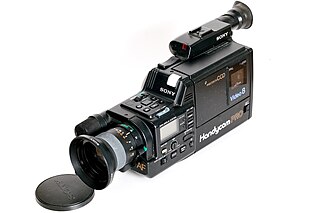
Sony Corporation produces professional, consumer, and prosumer camcorders such as studio and broadcast, digital cinema cameras, camcorders, pan-tilt-zoom and remote cameras.
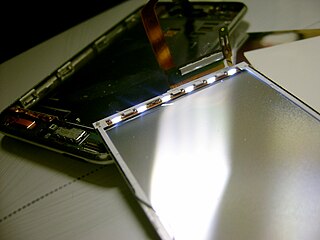
An LED-backlit LCD is a liquid-crystal display that uses LEDs for backlighting instead of traditional cold cathode fluorescent (CCFL) backlighting. LED-backlit displays use the same TFT LCD technologies as CCFL-backlit LCDs, but offer a variety of advantages over them.
"21:9" is a consumer electronics (CE) marketing term to describe the ultrawide aspect ratio of 64:27, designed to show films recorded in CinemaScope and equivalent modern anamorphic formats. The main benefit of this screen aspect ratio is a constant display height when displaying other content with a lesser aspect ratio.

4K resolution refers to a horizontal display resolution of approximately 4,000 pixels. Digital television and digital cinematography commonly use several different 4K resolutions. In television and consumer media, 3840 × 2160 with a 16:9 aspect ratio is the dominant 4K standard, whereas the movie projection industry uses 4096 × 2160.
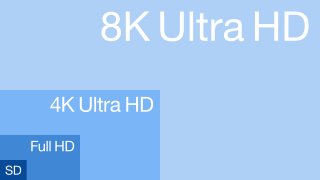
8K resolution refers to an image or display resolution with a width of approximately 8,000 pixels. 8K UHD is the highest resolution defined in the Rec. 2020 (UHDTV) standard.
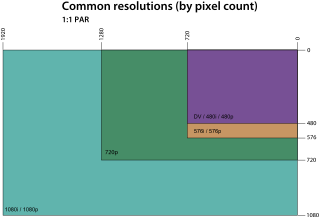
A display resolution standard is a commonly used width and height dimension of an electronic visual display device, measured in pixels. This information is used for electronic devices such as a computer monitor. Certain combinations of width and height are standardized and typically given a name and an initialism which is descriptive of its dimensions. A graphics display resolution can be used in tandem with the size of the graphics display to calculate pixel density. An increase in the pixel density often correlates with a decrease in the size of individual pixels on a display.

ITU-R Recommendation BT.2020, more commonly known by the abbreviations Rec. 2020 or BT.2020, defines various aspects of ultra-high-definition television (UHDTV) with standard dynamic range (SDR) and wide color gamut (WCG), including picture resolutions, frame rates with progressive scan, bit depths, color primaries, RGB and luma-chroma color representations, chroma subsamplings, and an opto-electronic transfer function. The first version of Rec. 2020 was posted on the International Telecommunication Union (ITU) website on August 23, 2012, and two further editions have been published since then.

The Sony Xperia Z2 is an Android-based smartphone unveiled, manufactured, and marketed by Sony and was released in April 2014. Under the codename "Sirius", Xperia Z2 serves as the successor to the Sony Xperia Z1. Like its predecessor, the Xperia Z2 is water and dust proof with an IP rating of IP55 and IP58. The phone features an IPS LED display, a Snapdragon 801 processor and the ability to record 4K videos. The Xperia Z2 also allows removable microSD storage up to 128 GB.
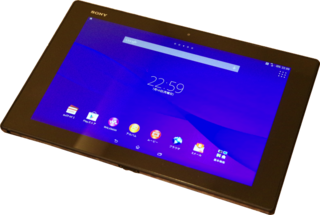
The Sony Xperia Z2 Tablet is a touchscreen Android tablet manufactured and designed by Sony. Like its predecessor, the Xperia Z2 tablet features a 10.1 inch screen and is water and dustproof with a rating of IP55 and IP58. The tablet is the lightest and thinnest 10.1-inch tablet, weighing at 1 pound and is 0.25 inches (6.4 mm) thick, the Z2 Tablet features the Snapdragon 801 processor, Sony's Triluminos display and HDR video recording. Unveiled alongside the Sony Xperia Z2 during the 2014 Mobile World Congress in Barcelona, Spain, on February 24, it was first released on March 26, 2014 in the United Kingdom. On July 3, 2014, Sony launched its Xperia Z2 Tablet in India. On July 27, 2014 Sony released the Z2 Tablet in the US on Verizon.

Ultra-high-definition television today includes 4K UHD and 8K UHD, which are two digital video formats with an aspect ratio of 16:9. These were first proposed by NHK Science & Technology Research Laboratories and later defined and approved by the International Telecommunication Union (ITU).

The hybrid log–gamma (HLG) transfer function is a transfer function jointly developed by the BBC and NHK for high dynamic range (HDR) display. It's backward compatible with the transfer function of SDR. It was approved as ARIB STD-B67 by the Association of Radio Industries and Businesses (ARIB). It is also defined in ATSC 3.0, Digital Video Broadcasting (DVB) UHD-1 Phase 2, and International Telecommunication Union (ITU) Rec. 2100.

The Sony Xperia XZ1 is an Android smartphone manufactured and marketed by Sony. Part of the Xperia X series, the device was announced to the public along with the Xperia XZ1 Compact at the annual IFA 2017 on August 31, 2017. It is the direct successor to the Sony Xperia XZ according to Sony, and is the latest flagship after the Xperia XZ Premium.
The Sony Xperia XZ2 Premium is an Android smartphone manufactured and marketed by Sony. Part of the Xperia X series, the device was announced to the public on April 16, 2018, featuring a 4K HDR display and a MotionEye™ Dual Camera.

The Sony Xperia 1 is an Android smartphone made by Sony. Part of Sony's flagship Xperia series, the device was announced to the public at a press conference held at the annual 2019 Mobile World Congress event on February 25, 2019. It’s the world's first smartphone with an ultrawide 21:9 aspect ratio 4K HDR OLED display, dubbed Cinema Wide, and Sony's first triple-lens camera system featuring Eye AF eye-tracking technology seen in the company's Alpha line of professional-grade cameras. The Xperia 1 was later joined by a more compact device, the Xperia 5, which was revealed on 5 September 2019. Compared to the Xperia 1, the Xperia 5 has a smaller 1080p screen, a smaller battery, and a non-centrally aligned camera module.

The Sony Xperia 1 III is an Android smartphone manufactured by Sony. Designed to be the new flagship of Sony's Xperia series, the phone was announced along with the compact flagship Xperia 5 III and the mid-range Xperia 10 III on April 14, 2021.

The Sony Xperia 1 IV is an Android smartphone manufactured by Sony. Launched on May 11, 2022, it succeeds the Xperia 1 III as the latest flagship of Sony's Xperia series. The device was announced along with the mid-range Xperia 10 IV, with expected release dates by June 2022 and as late as September 2022 for other markets including the US. US shipments were delayed and ultimately began in late October 2022.














